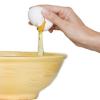news
Cracking a Hard Problem: Recovering Calcium Carbonate from Eggs
Primary tabs
Dr. Jeffery Hsieh and his team of researchers have successfully developed a novel separation technology and built a pilot-scale separation facility to recover calcium carbonate from eggshells for commercial use. Funded by Georgia's Traditional Industries Program for Food Processing, the project focused on developing a process that extracts value-added byproducts from eggshell waste. More than 37 million pounds of eggshells find their way to landfills each year in Georgia.
Dr. Hsieh proposes that there is an alternative to wasting the calcium carbonate from eggshells because it is renewable and can be used as a partial substitute for mined calcium carbonate, which is used in paper and plastic manufacturing. For example, the calcium carbonate can be used as a component in ink jet paper coatings or compounded into plastics to reduce the use of petroleum-based products.
Working with industrial partner American Dehydrated Foods (ADF), the research team constructed a pilot-scale separation facility at ADF's egg processing plant in Social Circle, Ga. The pilot-scale system can process 500 pounds of eggshells per day, thus allowing researchers to generate greater volumes of calcium carbonate for use in product testing and to evaluate the system's design under actual process conditions.
The pilot unit, explains Dr. Hsieh, has a series of washing stations that subject the eggshells to severe agitation in order to separate the membrane from the calcium carbonate. The eggshells are ground into small pieces and fed through the system counter to the flow of water. This countercurrent path helps to separate the membrane from the calcium carbonate. The membrane is lighter than water and floats out, whereas the calcium carbonate falls through to the bottom.
"The ultimate goal is to have a calcium carbonate that is clean, or in other words, has no biologic activity, with a very low level of membrane still attached," says Dr. Hsieh. The membrane has to be at low levels so that subsequent grinding of the calcium carbonate is not impaired. The research team has been able to make a clean calcium carbonate and reduce the amount of membrane. But, Dr. Hsieh says, the membrane still has to be reduced more.
Researchers are now exploring methods to reduce the amount of remaining membrane. "We have shown that the amount of membrane can be reduced to slightly below a two percent level with only mechanical separation," says Dr. Hsieh. The team has decided on evaluating three different approaches to reduce the membrane.
Interest in the project remains strong among industrial collaborators. EvCo Research, a supplier of coating and wet end treatment chemicals to the paper industry; Imerys, a mineral processor; and Heritage Plastics, a plastics compounder and processor, have all expressed a desire to use the calcium carbonate in the manufacturing of their products.
Ultimately, the project should yield significant environmental benefits. Dr. Hsieh says that the "successful conclusion of the project will provide the poultry industry with an environmentally better solution than landfilling eggshells. In addition, the calcium carbonate can be used to replace petroleum-based plastics, reducing America's dependence on foreign oil feedstocks."
Status
- Workflow status: Published
- Created by: Josie Giles
- Created: 07/15/2008
- Modified By: Fletcher Moore
- Modified: 10/07/2016
Categories

